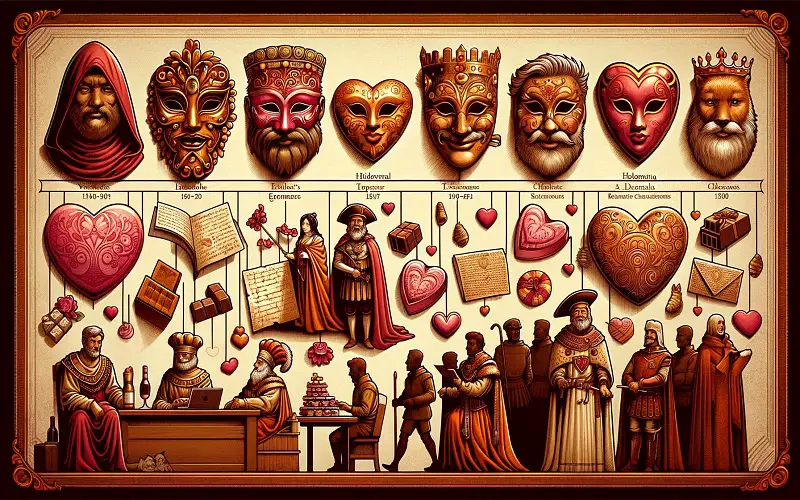They say love makes the world go round, and what better time to celebrate it than on Valentine’s Day? As you prepare to embrace the season of love, have you ever wondered about the history, meaning, and traditions behind this cherished holiday?
From its humble beginnings as a religious observance to its transformation into a day dedicated to love and romance, Valentine’s Day has a fascinating story to tell. But that’s not all – there are also captivating legends, enchanting traditions, and heartwarming gestures that make this day truly special.
So, hold onto your curiosity, because we are about to unravel the captivating world of Valentine’s Day, and you won’t want to miss a single detail.
Origins of Valentine’s Day
The origins of Valentine’s Day can be traced back to the ancient Roman festival of Lupercalia. In ancient Rome, Lupercalia was a festival celebrated from February 13th to 15th. It was a pagan festival dedicated to fertility and the Roman god of agriculture.
However, as Christianity spread, the Catholic Church sought to replace pagan festivals with Christian celebrations. Pope Gelasius declared February 14th as St. Valentine’s Day, in honor of St. Valentine, a priest or bishop who was martyred for his faith.
The association of love and romance with Valentine’s Day began to develop during the Middle Ages. One legend suggests that Roman Emperor Claudius II banned marriages because he believed that single men made better soldiers. However, St. Valentine continued to perform secret marriages, leading to his martyrdom.
Thus, Valentine’s Day became a day to celebrate love and romance, eventually evolving into the holiday we know today.
The Legend of St. Valentine
As we delve into the legend of St. Valentine, we uncover the mysterious identity and actions of this enigmatic saint associated with Valentine’s Day. The legends surrounding St. Valentine are varied and intriguing, adding to the mystique of this figure in history.
Here are three key aspects of the legend:
- Secret Marriages: One legend suggests that St. Valentine was a priest who defied the Roman Emperor’s decree and performed secret marriages for young couples in love. This act of rebellion against the unjust laws of the time contributed to the association of St. Valentine with love and romance.
- Prison Escape: Another legend claims that St. Valentine helped Christians escape Roman prisons, where they were often subjected to harsh conditions and persecution. This act of compassion and bravery further solidified his place as a symbol of love and devotion.
- ‘From Your Valentine’: St. Valentine is known for writing a letter signed ‘From your Valentine’ to a young girl whom he’d befriended while in prison. This phrase has endured through the centuries and is still used today as a heartfelt expression of affection and love on Valentine’s Day.
The legend of St. Valentine continues to captivate us, reminding us of the enduring power of love and the importance of cherishing our loved ones on this special day.
Evolution of Valentine’s Day
With its origins potentially stemming from the Roman festival of Lupercalia, the evolution of Valentine’s Day has transformed the holiday into a celebration of love and devotion. Originally declared by Pope Gelasius in the 5th century as a religious holiday to replace Lupercalia, Valentine’s Day has undergone significant changes over time.
From a more theatrical interpretation of its original form, the holiday gradually became associated with love and romance, thanks to Geoffrey Chaucer’s poem in the 14th century. The Normans even celebrated Galatins Day, likely confused with St. Valentine’s Day due to similar sounds.
In the 19th century, the Industrial Revolution introduced factory-made cards, further shaping the tradition. Today, Valentine’s Day is celebrated on February 14th every year, and individuals choose to express their love and appreciation through gifts, romantic gestures, and special dinners.
The evolution of Valentine’s Day has truly made it a meaningful and cherished holiday for many.
Significance of Cupid
Cupid, the beloved symbol of love and romance, is often depicted as a naked cherub with a bow and arrow. As the Roman god of love, Cupid plays a significant role in the celebration of Valentine’s Day. His association with love and romance makes him a fitting symbol for the holiday.
Here are three reasons why Cupid holds such significance:
- Cupid’s roots in Greek mythology as Eros and his transformation into a mischievous child figure in the Hellenistic period give him a rich history.
- The image of Cupid as a winged child with a bow and arrow has become synonymous with Valentine’s Day, representing the power of love’s arrow striking the hearts of individuals.
- Cupid’s presence on Valentine’s Day serves as a reminder of the deep connections and affection we share with our romantic partners, friends, and family members.
As you celebrate Valentine’s Day, keep Cupid in mind as a symbol of love and the importance of cherishing those who hold a special place in your heart.
Traditional Valentine’s Day Celebrations
Valentine’s Day celebrations encompass a range of traditional activities and customs that are cherished by individuals worldwide. Exchanging Valentine’s Day cards is a common tradition, with heartfelt messages and declarations of love.
Red roses are a traditional symbol of love and are often given as gifts, expressing deep affection. Chocolates and other sweets are popular Valentine’s Day gifts, indulging in the sweet side of love.
Romantic dinners and date nights are common ways to celebrate Valentine’s Day, creating intimate settings for couples to connect and enjoy each other’s company. In some countries, such as South Korea and Japan, women give gifts to men on Valentine’s Day, and men reciprocate on White Day, reinforcing the spirit of mutual affection.
Ultimately, Valentine’s Day is a celebration of love, meaning different things to different people, but always cherished and celebrated in heartfelt ways.
How we celebrate now
As we shift our focus to the present, let’s explore how people currently celebrate this cherished day of love and affection, Valentine’s Day.
Here are some ways people celebrate now:
- Exchanging handmade or store-bought valentines, chocolates, and flowers remains a popular tradition on Valentine’s Day. It’s a way to express love and appreciation to romantic partners, friends, and family members.
- Romantic dinners and date nights have become a common way to celebrate Valentine’s Day. Couples often plan special outings or intimate meals to spend quality time together.
- Buying jewelry and flowers for loved ones is another way people celebrate Valentine’s Day. These thoughtful gifts symbolize affection and can make the day even more special.
As times change, the ways we celebrate Valentine’s Day may evolve, but the meaning of the day remains the same – an opportunity to express love and affection to those who are dear to us.
Final Thoughts
So, whether you’re exchanging heartfelt gifts with your partner, sending a sweet message to a friend, or embracing the joy of female friendships on Galentine’s Day, Valentine’s Day is a time to celebrate love in all its forms.
Just as Cupid’s arrow strikes the heart, this day reminds us of the power of love to bring joy and happiness into our lives.
So go ahead, spread the love and make this Valentine’s Day a truly special one.




